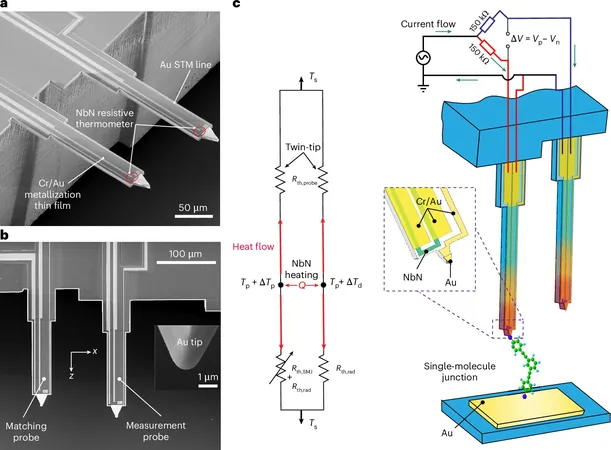
Revolutionary Thermal Sensor Unlocks Secrets of Heat Control at Molecular Level
2025-05-07
Author: Mei
A Groundbreaking Discovery in Phononics
Imagine strumming a guitar—each note created by plucking a string generates sound waves that can either amplify or cancel one another. Now, envision shrinking this concept to the molecular scale, where vibrations convey heat instead of sound. A research team at the Paul M. Rady Department of Mechanical Engineering at CU Boulder has unveiled how these molecular vibrations, known as phonons, can interfere with one another, much like music—potentially leading to groundbreaking advances in heat management for future technology.
Published in the prestigious journal *Nature Materials*, this pioneering study was spearheaded by Assistant Professor Longji Cui and his innovative research group, in collaboration with esteemed institutions across Spain and Italy. This discovery marks the first-ever observation of phonon interference at room temperature on a molecular scale, opening doors to previously unimagined applications.
Innovative Technology to 'Listen' to Molecular Vibrations
Cui emphasizes that understanding interference at such a tiny level could revolutionize device design. While molecular phononics had been largely theoretical, the team's cutting-edge thermal sensor—a marvel smaller than a grain of sand—enables precise measurements of phonon vibrations. This unprecedented resolution allows researchers to capture and analyze heat flow within individual molecular junctions, revealing the potential for phonons to cause destructive interference, thereby reducing heat transfer.
Lead author Sai Yelishala notes this marks a significant leap forward. "Think of two ocean waves crashing into each other; that’s the destructive interference we’ve witnessed in our experiments," he explains. This knowledge could ultimately allow scientists to better manage heat flow at the very heart of material composition.
Enormous Implications for Future Materials
What can these tiny vibrations achieve? Yelishala foresees vast potential for molecular phononics. As electronics grapple with heat dissipation issues that threaten performance and durability, insights from this research could lead to innovative solutions. Imagine transforming a simple polymer, known for its weak thermal conductivity, into a high-performance material akin to metal, designed to effectively transport heat by harnessing constructive phonon vibrations.
Furthermore, the implications extend beyond traditional materials into the realm of thermoelectricity, where the ability to efficiently convert heat into electricity is crucial for sustainable energy advancements.
A Bright Future Awaits
This groundbreaking study is just the beginning, with Cui and his team eager to expand their research into other phononic characteristics. With the ability to guide improvements across both natural and synthetic materials, their ultra-sensitive probes could unlock revolutionary advancements in science and technology.
"Phonons are present in virtually all materials, and our research offers a roadmap to navigate their endless possibilities," Yelishala concludes. Prepare for a future where we can manipulate heat at the molecular level like never before!


 Brasil (PT)
Brasil (PT)
 Canada (EN)
Canada (EN)
 Chile (ES)
Chile (ES)
 Česko (CS)
Česko (CS)
 대한민국 (KO)
대한민국 (KO)
 España (ES)
España (ES)
 France (FR)
France (FR)
 Hong Kong (EN)
Hong Kong (EN)
 Italia (IT)
Italia (IT)
 日本 (JA)
日本 (JA)
 Magyarország (HU)
Magyarország (HU)
 Norge (NO)
Norge (NO)
 Polska (PL)
Polska (PL)
 Schweiz (DE)
Schweiz (DE)
 Singapore (EN)
Singapore (EN)
 Sverige (SV)
Sverige (SV)
 Suomi (FI)
Suomi (FI)
 Türkiye (TR)
Türkiye (TR)
 الإمارات العربية المتحدة (AR)
الإمارات العربية المتحدة (AR)